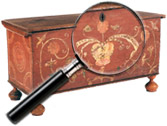|
|
Samuel Fiske (1769-1797)
Born in Waltham, Massachusetts, Samuel Fiske worked as a cabinetmaker in Dorchester with Stephen Badlam. Fiske had his own shop in Salem, probably beginning in the 1780s, and was in Boston on Washington Street by the 1790s. Known items include a Hepplewhite mahogany card table signed in chalk, “S. Fisk/Cabinate Maker/Bofton” and Hepplewhite shield-back side chairs branded “S.F.”
(Source: William C. Ketchum, Jr., American Cabinetmakers: Marked American Furniture, 1640-1940)
Frank Fiske (1883 to 1952)
Frank Fiske was born in June 11, 1883, the son of a military man stationed at Fort Bennett, (Dakota Territory) South Dakota. In 1889 his father was hired as a civilian wagon master at Fort Yates, near the Standing Rock Reservation. As a child, Frank attended school both at the fort and at the Indian boarding school. During part of his boyhood, Fiske learned the trade of photography from [...] Click here to continue reading.
Virgil Finlay (1914 to 1971)
Virgil Finlay has been described as the most popular interior illustrator ever to work in science fiction magazines. His method, influenced by the art of Gustave Dore, was to use a lithographic pen and ink to produce stipple art, or a dotted photographic effect. After World War II, Finlay had converted to Judaism. His new faith was distinctively reflected in this artwork.
Information courtesy of Morphy Auctions, December 2007
Peter M. Fillerup (born 1953 )
Peter M. Fillerup, son of noted Western painter Mel Fillerup, was born in Cody, Wyoming. He took an interest in sculpture, most notably Western subject matter. Major commissions include life-size statues commemorating Utah’s centennial.
Information courtesy of Cowan’s Auctions Inc., March 2007
John Field, Clockmaker
John Field, clock and machine maker, was born in 1756 in Beverly, Massachusetts and died in January 1829 in Pawtucket, Rhode Island.
From the “Town of Pawtucket Historical Sketch”, 1876, by Rev. Massen H. Goodrich: “…an ingenious clockmaker early in the 19th century by the name of John Field introduced the casting of brass in Pawtucket.”
From the Pawtucket Gazette: “After the Revolutionary War John Field settled in Pawtucket and for [...] Click here to continue reading.
Erastus Salisbury Field (1805-1900)
Erastus Salisbury Field is one of the new Republic’s most highly regarded folk painters as well as one of the most highly documented – with over 1,000 signed or attributed works known, ten to fifteen of them signed.
Field, (born in Liverett, Massachusetts on May 19, 1805) worked in central New England during the 1824 to 1842 period, mostly in Massachusetts and Connecticut. He is distinguished as one of [...] Click here to continue reading.
John Fery (1859 to 1934)
John Fery was born in Strasswalchen, Austria to a wealthy family. He studied art in Vienna, Dusselforf and Munich and eventually immigrated to the U.S. in 1886. He lived mostly in the West and Pacific Northwest. He is best-known for his detailed panoramic landscapes.
Information courtesy of Manitou Galleries/Manitou Auction
Claude Lorraine Ferneley (British 1822-1892)
Claude Lorraine Ferneley was born in the Melton Mowbray. He was the son of John E. Ferneley (one of the top British equestrian painters) and he often helped out by painting in the background of his fathers pictures. He was also adept at painting copies of his father’s paintings at clients’ request. Claude was obviously influenced by his father’s style and he is most noted for his paintings of [...] Click here to continue reading.
Favorite Piqua Ware Cast Iron Cookware
Favorite Piqua Ware cast iron cookware was made by the Favorite Stove & Range Company of Piqua, Ohio primarily during the first quarter of the 20th century. The company’s forerunner, The Favorite Stove Works, was founded in Cincinnati and moved to Piqua circa 1890. Favorite Piqua Ware cookware was introduced at this time with production lasting to the Great Depression.
Lynn Fausett (1894 to 1977)
Lynn Fausett’s work falls into the Western landscape tradition. Painted with extreme precision, it is possible to identify every crease in the mountains, every tree on the hillsides. His compositions highlight the impressive grandeur of Utah, focusing on dramatic rock formations that seem to rise from the plain without any prelude. There is a sense of the sublime, although it is not explicit, and power emanates from the rocks [...] Click here to continue reading.
|
Recent Articles
- Charles Alfred Meurer – American Artist & Tromp L’Oeil Artist
- Sendak, Maurice – American Artist & Writer
- Godie, Lee – American Artist
- Davis, Vestie – American Artist
- Bartlett, Morton – American Artist
- Mackintosh, Dwight – American Artist
- Evans, Minnie Jones – African-American Artist
- Mumma, Ed (Mr. Eddy) – American Artist
- Nice, Don – American Artist
- Savitsky, John (Jack) – American Artist
- Gordon, Harold Theodore (Ted) – American Artist
- Dial, Thornton – African-American Artist
- Doyle Sam – American Artist
- Johnson, Lester Frederick – American Artist
- Finster, Howard – American Artist
|
|
